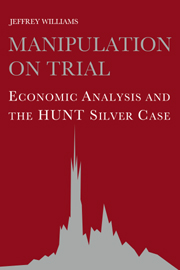Book contents
- Frontmatter
- Contents
- List of figures
- List of tables
- Preface
- Foreword by Thomas O. Gorman
- 1 Why the Hunt silver case?
- 2 Turmoil in the silver market
- 3 Identifying a manipulation
- 4 Testing for the cause of the price rise in silver
- 5 Determining the appropriate price of silver
- 6 Inferring manipulative intent
- 7 The predicament of economic analysis in the courtroom
- Glossary of commodity market terms
- References
- Index
2 - Turmoil in the silver market
Published online by Cambridge University Press: 17 September 2009
- Frontmatter
- Contents
- List of figures
- List of tables
- Preface
- Foreword by Thomas O. Gorman
- 1 Why the Hunt silver case?
- 2 Turmoil in the silver market
- 3 Identifying a manipulation
- 4 Testing for the cause of the price rise in silver
- 5 Determining the appropriate price of silver
- 6 Inferring manipulative intent
- 7 The predicament of economic analysis in the courtroom
- Glossary of commodity market terms
- References
- Index
Summary
Bunker and Herbert Hunt bought their first silver futures contracts in 1973. Within a year they began to acquire bullion by occasionally taking deliveries on their contracts. By January 1, 1979, they had accumulated some 37 million troy ounces of bullion as well as 25 million troy ounces in futures positions, controlling silver worth $375 million at prevailing prices.
The Hunts were attracted to silver out of an abiding doubt that governments act in the interests of private investors. Bunker Hunt had suffered the 1973 nationalization of his share in the mammoth Sarir oil field in Libya. At home, the brothers saw their financial assets threatened by increasing inflation and a declining dollar, trends they interpreted as the U.S. government abrogating the responsibility it took on when it issued bonds. Although not among those cranks wanting a collapse of the world financial system and a return to silver currency, they nonetheless concluded that physical assets were less likely to depreciate than financial assets. In silver they found a close equivalent to a financial asset, yet one beyond the influence of governments. (Gold bullion, another candidate for this role, could not be owned by U.S. citizens in 1973.) The Hunts therefore formulated the strategy: buy silver, not U.S. Treasury bonds.
Actually, as a hedge against a decline in the value of financial assets, physical assets of any sort, whether gold, silver, copper, oil, soybeans, sugar, or coffee, performed handsomely in the early 1970s, as the Hunts well knew.
- Type
- Chapter
- Information
- Manipulation on TrialEconomic Analysis and the Hunt Silver Case, pp. 20 - 63Publisher: Cambridge University PressPrint publication year: 1995



